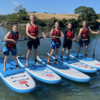How to Fall off your Board & Get Back On
Falling off and getting back on a SUP board is something that many paddlers fear. I have a few students who hired me just for a falling/recovery clinic. And there’s others who have never fallen and probably look stiff while paddling. I’ve heard a few times, “I’ve paddled 12x (or 2yrs) and haven’t fallen off yet!” The downside here is that their paddling experience is mostly uncomfortable while fearing the unknown. There’s no shame in falling, I do it all the time. You’ll be a better paddler if you do fall and can get back on by yourself.
All my beginning students learn to fall of and get back on. Here’s the methods I use for each. I teach both how to get on in the middle of the board and on the tail. Here we’ll cover getting on in the middle.
Jumping Off
Many who jump off a board do so as if jumping of a dock. My main suggestion to to never dive off a board unless you know for sure it’s deep enough to avoid a neck injury. Also make sure there not other boards or fins in your path.
In my classes we do a pivot turn to fall off – so you learn how to push your pivot turn skills and also learn how to fall of the board with style.
Falling
Wear a Leash – Ever fall of a board and have it take off, then you have to swim after it? Imagine doing so in light to heavy wind or current. Good luck catching it. Falling it a lot easier when you don’t have to chase your board and can keep it right next to you when it’s time to get back on.
Wear a Vest Style PFD (Type 3) – In every environment except surf, the vest style PFD will keep you afloat when injured or tired and will keep you warmer when cold. When you fall off a board it prevents you from sinking down very far and when you’re not treading water to stay afloat, it’s a lot easier to gather your paddle and board to get back on.
Fall to the Side – Usually we don’t have much choice of how we fall. But if you do, try to fall to the side of your board. When falling don’t try to brace your fall with your hand as you can sprain your thumb (been there) or wrist if it catches on the rail.
Fall Flat – For surfing, a friend suggested always falling using the NesTea Plunge – that is flat on the surface of the water to prevent your body from sinking. Usually surf happens in shallow water, so diving is sketchy, falling on the side could be an issue of ankle sprain but falling flat is most safe.
Hold on to Your Paddle – Whenever you fall of the board, hold onto your paddle. Certainly there are times in shallow water where doing so may be an issue of a shoulder injury but in deep water you don’t want to go find your paddle after falling. If you drop it – get on the board first then prone paddle (on your chest, hands as paddles) to the paddle.
Getting Back on in the Middle
Look Around – Before getting back on, look around to make sure there’s no immediate hazards such as oncoming boats, waves, etc. If there’s strong wind, climb on facing downwind (wind at your back). If you get on facing the wind, the board may flip you back in the water when the wind hits the rail you’re pulling up on.
Move yourself in the water to the middle of the board. – If it’s not deck up, then flip it over so the fin is down. Moving slightly on the board to grab the opposite rail then falling back can flip it as well.
Hold on to the Paddle – and put it on the deck while holding with one hand.
Grab the deck handle – or if you have longer arms the opposite rail.
Kick your feet in the water vigorously – Make sure the water is splashing behind you, like a strong kick when swimming. This will bring your body to the surface which makes it easier to get on the board. If you don’t do this and have poor upper body strength, you’ll be pulling your body up vs sliding on from the side. Keep kicking until you’re 100% on the board and can turn around to sit or stand back up. Remember to face the nose or front of the board.
Downsides of this approach:
– Some bulky Type 3 PFDs, front positioned inflatable PFDs or large chested folks may catch those items on the rail as they try to climb on. Kicking so your body rises flat on the surface minimizes these issues. Can’t get on at all? If with a buddy, consider learning the Flip Rescue, (search blog) or get a board with less volume thus thinner rails.
Tips:
– Rub on surfer’s wax on your rails to make them easier to grab onto while in the water and climbing on. Some even wax slippy deck pads as well.
– Practice in shallow water (chest deep) with a friend.
– Learn the Flip Rescue to help others who can’t get on or to instruct a rescuer to assist you in getting on. http://stokemagazine.blogspot.com/2013/01/flip-rescue-for-sup-addiitonal-tips.html
Plan B for getting back on a SUP? Cowboy Rescue – from the tail. I’ll cover that soon.







